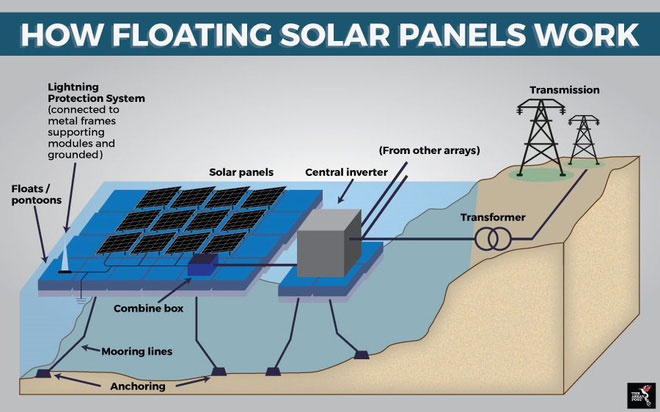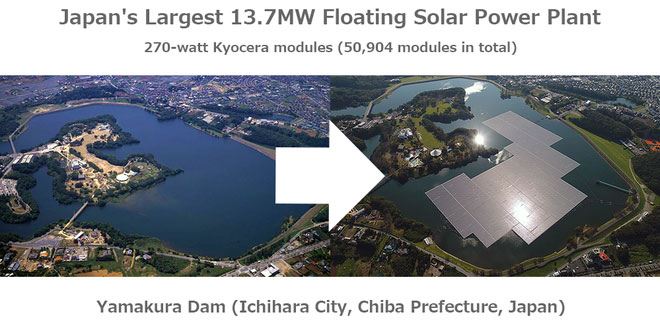This is the best way to deploy solar power if there is not much land available
In fact, not all houses are suitable for deploying solar roof systems by factors such as terrain, environment, obstructions, usable area, etc. For example, many solar power plants Large scale took advantage of space on the ground or trees. In addition, researchers have found an effective alternative to the traditional way of floating solar power. So what is solar power?
Floating solar power: New trend in the world
Known as the new trend of the energy industry, floating solar power includes photovoltaic battery systems that are fixed to floating structures on the water. The ideal location for floating solar power projects is still water areas such as lakes, artificial dams. After the transformation process, electricity will be transmitted through underground cables to the storage and distribution system.

Principle of operation of floating solar power system.
The first patents of floating solar power technology were registered in 2008. Since then, many countries around the world have begun building large solar floating solar power plants. It is forecasted that the total value of floating solar market worldwide will increase exponentially, from 13.8 million USD in 2015 to 2.7 billion USD in 2025, according to research by Grand View Research.
Israel is a pioneer in building and testing floating solar power technology. In 2011, the founder of Solar Synergy Yossi Fisher and Dr. Yuri Yokotov announced the idea of a solar cell system mounted on a structure made of ultra-light plastic and fiberglass into "modules like Lego." ", linked together in a grid form. This method helps overcome the two major disadvantages of traditional solar power, which is the cost of production from silicon and the requirement for space, and brings Solar Synergy to the first prize in the National Clean Technology Competition (Isarel National Cleantech Open IDEAS) at Tel Aviv University.

Yamakura Floating Solar Power System in Chiba Prefecture, Japan.
According to data from the US National Renewable Energy Laboratory (NREL), Japan is a country especially interested in floating solar power technology with 73 out of 100 big projects in operation since 2007. With less flat terrain and limited land resources, this solution helps the Japanese government take advantage of the potential of agricultural reservoirs, flood control lakes or coastlines.
In early 2016, Kyocera Group plans to start the Yamakura floating solar power plant located on the reservoir of Yakamura dam (Chiba Prefecture). Tens of thousands of solar panels covering an area of 180,000 square meters are expected to provide electricity for 5,000 local households. Notably, this is Kyocera's fourth project after two other floating solar power plants operate from March and June 2015.
China is the biggest investor for renewable energy. In June 2019, Sungrow officially launched the world's largest floating photovoltaic farm with a capacity of 40 MW, enough to meet the electricity demand for 15,000 households in Hoai Nam city ( Anhui province). Solar panels are located on the surface of the lake with a depth of 4-10m, belonging to a long-time coal mining area. The project is part of the Chinese government's five-year plan to replace 100 coal-fired plants by the end of the year.
Advantages and disadvantages of floating solar power
The most significant advantage of floating solar power is the low cost of precious land resources. While to be able to build a solar power plant with an output of 1GW (1GW = 1,000 MW) needs a surface area of up to about 1,300ha (1.3 million m2), the solar PV system is likely to be the ability to exploit the empty space of existing buildings such as the lake dams for waste water treatment. The installation of photovoltaic batteries on water also limits the need to remove trees and clear forests. At the same time, the water block below will cool the upper floating device, increasing the power output by 15-20% when constantly operating under high temperature.
The World Bank study in conjunction with the Singapore Solar Research Institute (SERIS) also found that floating solar cell structures contribute to a 70% reduction in evaporation due to limited air circulation and sunlight. shining on the water. It is also an important advantage, extremely useful in places where drought occurs frequently. Furthermore, the cover shade helps prevent the development of blooming algae causing pollution of freshwater resources, thereby limiting the cost of renovation.

Chinese workers are installing floating solar power systems in Huainan City.
However, the expensive cost of floating solar power system is the biggest barrier for developing countries. New technology requires specialized equipment and a team of specialized engineers. In addition, investors in this system often deploy in large waters, only suitable for installing hundreds to thousands of solar panels (compared to civil solar systems usually only about 20 battery plate). Therefore, the implementation of small solar floating power system is almost impossible.
Potential solar power floating in Vietnam
Vietnam owns a long coastline, many rivers and lakes, especially the system of hydropower reservoirs in operation. This is a very favorable condition for the deployment of floating solar power plants. More importantly, less impact on the land fund means less clearance costs for installing solar panels.

The solar power plant floating on Da Mi hydropower reservoir (Binh Thuan) officially closed electricity 33 days earlier than originally planned.
Realizing this potential, Vietnam Electricity (EVN) has advocated to promote the development of floating solar power technology. The first project in Vietnam built at Da Mi lake (Binh Thuan) has been in operation since May 5, 2019. With a capacity of 47.5 MW, the system will generate an average power output of over 70 million kWh / year.
In addition, there is a floating solar power project in Buon Kuop, Dak Lak, 50MW and Srepok, Dak Lak, 50 MW hydroelectric reservoirs, invested by EVNGENCO 3.
As a latecomer in this technology, Vietnam can learn and learn from the world. However, in the first stage, we should focus on studying the effect of water shading by installing solar cell systems on aquatic environment and aquaculture production, as well as examining the weaknesses. Factors affecting performance from this solar power source.
- China built the world's largest floating solar power plant
- The world's largest floating solar power plant
- Toshiba will enter the solar market
- Top 10 countries to exploit solar power in the world
- The era of solar power
- New trend: Solar power floats on water
- Use solar power with high technology
- The world's largest solar power plant
- New solar cell batteries can generate electricity on both sides of the module
- Light up with solar power technology
- Apple invested in building two solar power plants in China
- The solar power plant is made of 10,000 giant mirrors
- The world's largest solar power plant comes into operation
- Operating the world's largest solar power plant
 The US company is about to build a supersonic passenger plane of 6,000km / h
The US company is about to build a supersonic passenger plane of 6,000km / h Japan develops avatar robot as in fiction film
Japan develops avatar robot as in fiction film Australia tested the world's first mango picking robot
Australia tested the world's first mango picking robot America develops technology to separate water from animal waste
America develops technology to separate water from animal waste Which planet is the largest in the Solar System?
Which planet is the largest in the Solar System?  The Sun goes into hibernation, will the Earth usher in a new ice age?
The Sun goes into hibernation, will the Earth usher in a new ice age?  263 extrasolar objects discovered, hinting at a mysterious belt outside the Kuiper Belt
263 extrasolar objects discovered, hinting at a mysterious belt outside the Kuiper Belt  Does the Solar System have 5 more planets similar to Earth?
Does the Solar System have 5 more planets similar to Earth?  Superstructure in space 'shades' Earth
Superstructure in space 'shades' Earth  US successfully transmits solar power from space to Earth
US successfully transmits solar power from space to Earth 